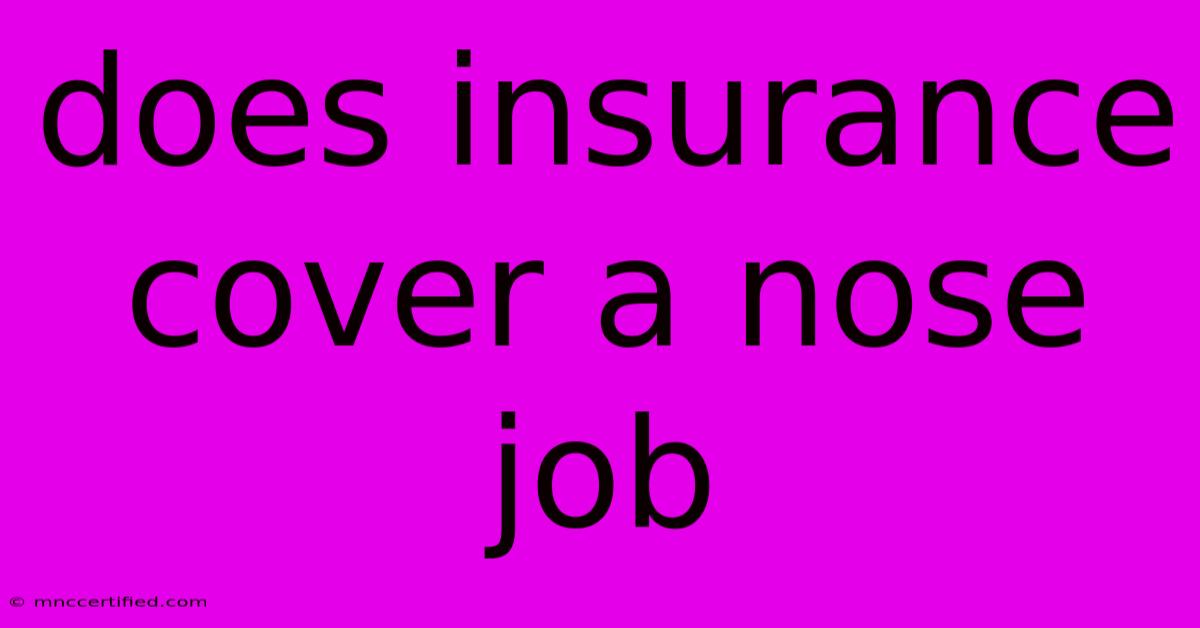Does Insurance Cover A Nose Job

Table of Contents
Does Insurance Cover a Nose Job? A Comprehensive Guide
Rhinoplasty, commonly known as a nose job, is a popular cosmetic procedure. But the question many potential patients ask is: does insurance cover a nose job? The short answer is: usually, no, unless the procedure is medically necessary. This article will delve deeper into the complexities of insurance coverage for rhinoplasty and help you understand your options.
When Insurance Might Cover Rhinoplasty
While cosmetic nose jobs rarely receive insurance coverage, there are specific circumstances where medical necessity can lead to approval:
1. Breathing Problems: The Key to Coverage
Insurance companies primarily cover medically necessary procedures. For a nose job to be considered medically necessary, it must address a significant breathing problem. This could include:
- Nasal obstruction: Difficulty breathing through the nose due to a deviated septum, nasal polyps, or other structural issues. A deviated septum, in particular, is a common reason for insurance to cover a portion or all of the surgery.
- Sinus issues: Chronic sinus infections or other sinus problems that are significantly impacting breathing and quality of life. If the rhinoplasty is part of a larger treatment plan to address these issues, insurance may cover a part of it.
- Sleep apnea: In some cases, a deviated septum or other nasal structural issues can contribute to sleep apnea. Rhinoplasty might be considered medically necessary as part of a broader sleep apnea treatment plan.
Important Note: Even with a breathing problem, insurance approval is not guaranteed. You'll need thorough documentation from your doctor detailing the medical necessity of the surgery and its direct impact on your breathing.
2. Trauma-Related Rhinoplasty
If your nose was broken or damaged due to an accident or injury, insurance might cover the reconstructive surgery needed to restore its function and form. This is considered a medically necessary procedure to repair damage and improve breathing. Documentation from your doctor and potentially accident reports will be required.
3. Congenital Defects
In cases where a patient has a congenital nasal deformity (a birth defect affecting the nose's structure), insurance may cover the necessary corrective surgery.
What to Expect When Seeking Insurance Coverage
Even if your rhinoplasty falls under a medically necessary category, the process can be complex:
- Pre-authorization: You'll likely need to obtain pre-authorization from your insurance company before scheduling the surgery. This involves submitting medical documentation to your insurance provider for review.
- Partial coverage: Even with pre-authorization, insurance rarely covers the entire cost of a rhinoplasty, even if deemed medically necessary. Expect to pay a significant portion out-of-pocket.
- Specific policy details: Your coverage will vary greatly depending on your specific insurance plan, provider, and state regulations. Review your policy carefully or contact your provider directly for detailed information.
What if My Insurance Doesn't Cover It?
If your insurance doesn't cover the rhinoplasty, you'll have to pay out-of-pocket. Consider these factors:
- Financing options: Many cosmetic surgeons offer financing plans to help spread the cost over time.
- Savings: Start saving early to cover the cost of the procedure.
- Realistic expectations: Understand the full financial commitment before proceeding with the surgery.
Key Takeaways
While purely cosmetic nose jobs are rarely covered by insurance, medically necessary rhinoplasty procedures may receive partial coverage. Thorough documentation from your doctor emphasizing the medical necessity is crucial. Always review your insurance policy carefully, discuss your options with your surgeon and your insurance provider, and be prepared for potential out-of-pocket costs. Understanding the complexities of insurance coverage for rhinoplasty will allow you to make informed decisions about your procedure.

Thank you for visiting our website wich cover about Does Insurance Cover A Nose Job. We hope the information provided has been useful to you. Feel free to contact us if you have any questions or need further assistance. See you next time and dont miss to bookmark.
Featured Posts
-
1 2 Millones De Wones A Dolares
Nov 23, 2024
-
Crypto Average Price Calculator
Nov 23, 2024
-
Peter Kay Silent On New Project Details
Nov 23, 2024
-
Nuno Mendes Latest Injury Report From Coach
Nov 23, 2024
-
Hunters Assist Mpd Missing Man Eric Boll Search
Nov 23, 2024